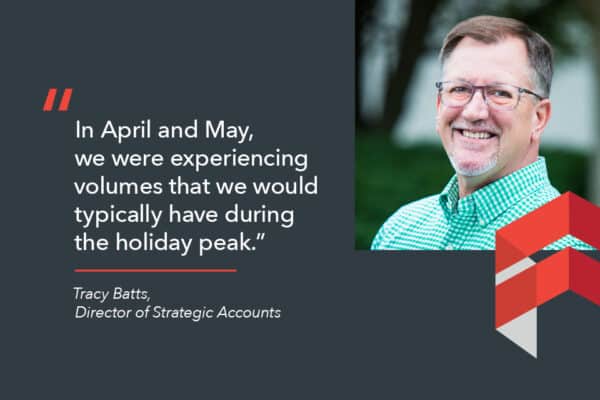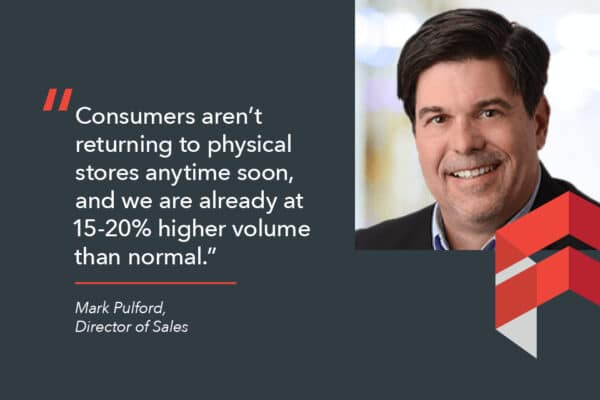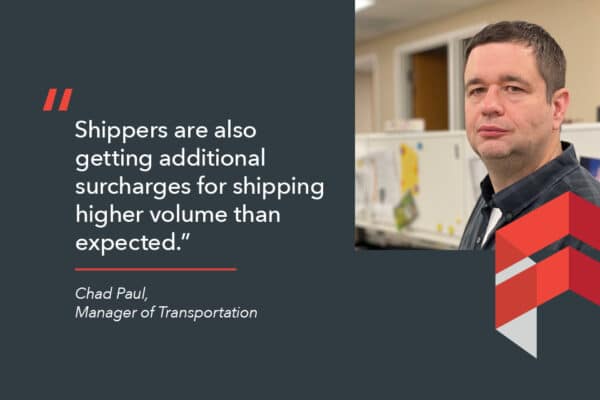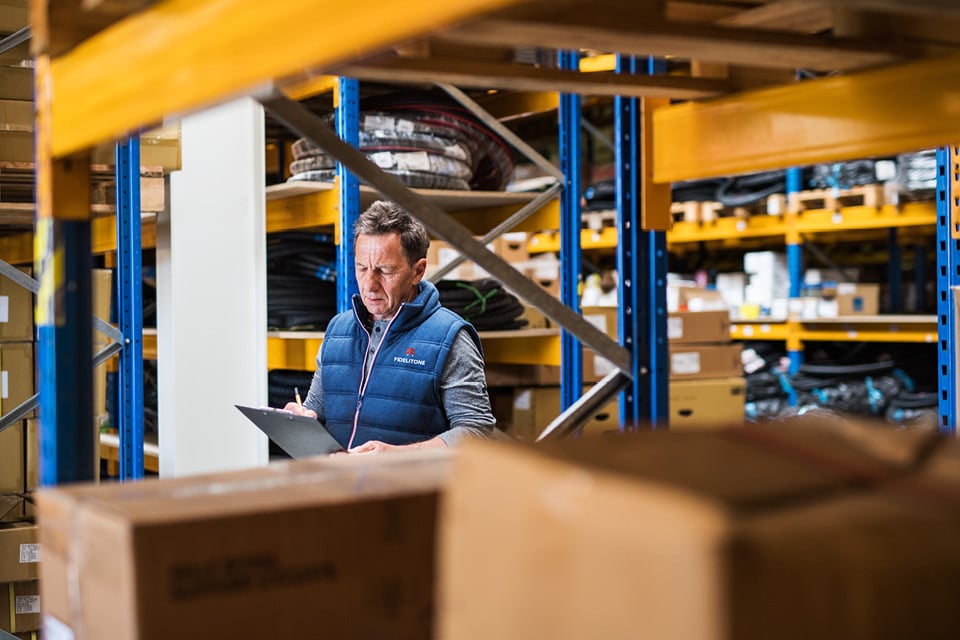How to manage customer expectations ahead of holiday shipping delays

It’s no secret that this year has seen record ecommerce growth amidst the pandemic. US ecommerce sales are predicted to reach $794.50 billion this year, up 32.4% year-over-year. “In April and May, we were experiencing volumes that we would typically have during the holiday peak,” says Tracy Batts, Director of Strategic Accounts at FIDELITONE.
While this is great news for ecommerce companies, the explosion of online sales has put a strain on parcel carrier networks. FedEx and UPS are advising retailers that they are nearly or entirely out of capacity in advance of the holiday shopping season. Throw in work stoppages for COVID-19 at parcel sortation centers and carriers experience further delays. Capacity is tight, demand is high and consumers are wondering “where’s my order?”

We brought in a variety of client perspectives to discuss how ecommerce brands can improve transit times and manage customer expectations ahead of the holiday season. Tracy brings in his customer experience expertise. Chad Paul, Manager of Transportation is our expert on all things 3PL. And Mark Pulford, Director of Sales has a strong background in B2B and B2C regional last mile parcel solutions.
What’s a typical parcel transit time?
“Transit times differ by service levels. Carries provide tables and calculators to help determine transit times,” says Tracy. Here are some baselines:
- Typical parcel transit times range from 2-6 days by ground service.
- The average transit time is 2.5-3 days by ground service.
- USPS transit time is 2-10 days.
- The customer’s expectation is 1-2 day transit time with free shipping.
“Transit times are measured in business days, not calendar days. While UPS and FedEx deliver on Saturdays, this is an expedited service,” says Mark
“A package scheduled for Friday that arrives on Sunday is considered on time. For carriers that use independent contractors, they may require delivery on non-business days in order to meet the service levels,” says Tracy.
How can you measure the actual transit time?
“You can manually measure the transit time with the tracking number on the carrier’s website and compare it to the service level you selected,” says Mark. “The experience can be automated to call the carrier API based upon the actual and published transit times. There are firms that specialize in this service and some fulfillment providers offer it as an upgrade,” says Chad.
Increased ecommerce demand combined with lower carrier capacity is causing delays.
“Parcel carriers used to have 95-97% on-time deliveries. Post COVID is dramatically different,” says Chad. As FedEx and UPS limit their capacity (how much can be shipped out of a certain location), delays have become more common. We recently ran two internal studies that tracked 2800 packages. Around 20% of the packages arrived late.
“The primary delivery method for ecommerce is USPS. However, there are network changes going on with USPS as well which is constraining capacity there too,” says Chad.
It’s important to manage customer expectations since shipping refunds are no longer available.
“Before COVID, UPS and FedEx expedited and ground service were guaranteed. The USPS guarantee is for priority mail only. If a package isn’t delivered within the published transit time, you have the right to request a refund. Some requirements need to be met in order to be eligible for a refund,” says Chad.
But as of March 26th, UPS has suspended its service guarantee. USPS hasn’t published any change to their guarantees. Since most refunds are no longer available, it’s important to manage customer expectations accordingly and plan for possible delays.
Customers can track the status of their shipment on the ecommerce brand’s website or by linking directly to the website of a carrier. If there’s a delay, the customer can have their package sent to a different address or pick it up at the local terminal or access point. However, the best course of action is to plan ahead. As an ecommerce brand, you should set the shipping expectations via information on your website and customer communication.

Start holiday promotions earlier in the year.
“Consumers aren’t returning to physical stores anytime soon, and we are already at 15-20% higher volume than normal,” says Mark. “Shippers are also getting additional surcharges for shipping higher volume than expected,” says Chad.
With increased ecommerce demand and higher costs, it’s important to get a head start on planning holiday promotions. Think Cyber November instead of Cyber Monday. Customers won’t be able to do their last minute holiday shopping online this year. The likelihood of someone getting a gift on time if they order a week before Christmas is different this year than in the past. Prepare to manage customer expectations in order to mitigate customer impact as much as you can. Encourage your customers to order their gifts earlier.

Here are some short-term solutions we recommend to manage customer expectations:
- Update the information on your shipping page to reflect longer transit times.
- Offer discounts to loyal customers who order sooner for the holidays.
- Create a holiday order guide based upon longer transit times – i.e. order by XX date to have your package by the holidays.
- Connect with your fulfillment partners to strategize.“It’s not just the last mile that can be affected. This year, every leg of the supply change is experiencing delays including manufacturing, imports, and ground transportation,” says Chad.
Consider adding an additional fulfillment center.
While there are a lot of factors at play right now with COVID and the holidays, there are some strategies you can implement to improve transit times over the long-term. One strategy is to utilize multiple fulfillment centers.
“If you utilize multiple warehouses or shipping points, you could achieve 1, 2 or 3 day transit times with Ground Service,” says Chad. Relocating your high moving SKUs closer to your customers can improve speed. To learn more, check out our blog post on what you need to know about adding a second order fulfillment center and capturing the “plus-one” advantage.
“Other long-term strategies include evaluating regional carriers. They offer the ability to gain capacity or improve performance in specific zip codes. Keep in mind, their networks are also experiencing increased demand,” says Mark.
FIDELITONE is here to help!
Our supply chain experts are always here to strategize with you on how to best manage customer expectations and mitigate shipping delays for your ecommerce business. Contact us today.
FIDELITONE helps you earn customers’ loyalty through specialized services in inbound logistics, order fulfillment, last mile delivery and service parts management.
Recent Posts
-

How to Choose a Global Ecommerce Fulfillment Partner
In today’s interconnected global economy, international trade is no longer a maybe, but for most…
-

Elevating Your Supply Chain: FIDELITONE’s Latest Facility Openings in Raleigh, Virginia Beach, and Reno
FIDELITONE is thrilled to announce the launch of three advanced facilities strategically positioned in Raleigh,…
-

How to Reduce Warehouse Costs in a Down Market
Order volumes have slowed down while excess warehouse capacity inches upward. How do you manage…
Are you interested in order fulfillment or last mile delivery services? Consult with a FIDELITONE expert to discuss how we can help.
